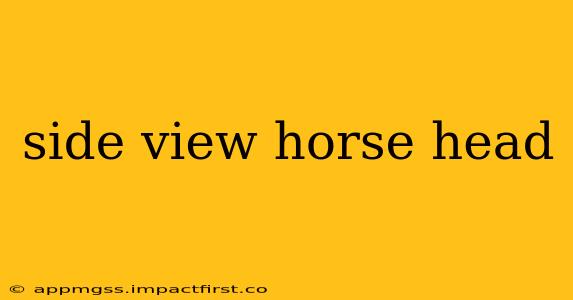The side view of a horse's head offers a unique opportunity to capture its elegance, power, and inherent beauty. Whether you're an artist striving for accuracy or a photographer aiming for that perfect shot, understanding the nuances of this perspective is crucial. This guide will explore the key elements involved in portraying a horse's head from the side, addressing common questions and providing insightful tips for both drawing and photography.
What are the key features to capture in a side view horse head drawing or photograph?
Successfully capturing a horse's side profile hinges on accurately depicting its distinct features. The most important aspects include:
- The Profile: The graceful curve of the neck leading into the head is fundamental. Pay close attention to the subtle shifts in curvature, from the crest of the neck to the jawline.
- The Muzzle: The muzzle's shape varies between breeds, but it's usually refined and proportionate to the overall head size. Carefully observe the nostrils, lips, and the way the light catches these areas.
- The Eye: The eye's placement is key to conveying the horse's expression. In a side view, the eye is typically slightly recessed and should be realistically proportioned to the rest of the head.
- The Ear: The ear's position, whether pricked forward, relaxed to the side, or slightly backward, dramatically impacts the horse's expression and overall demeanor.
- The Forehead and Crest: The forehead's shape, whether broad or narrow, contributes significantly to the breed's characteristics. Observe the subtle transition from the forehead to the crest of the neck.
How do I draw a realistic side view horse head?
Drawing a realistic horse's head requires patience and observation. Start with basic shapes to establish the overall form before adding finer details. Here's a suggested approach:
- Basic Shapes: Begin by sketching the basic shapes that make up the head – a circle for the skull, a slightly elongated oval for the muzzle, and lines to indicate the neck and ears.
- Refine the Structure: Refine the initial shapes, paying attention to the subtle curves and angles of the horse's head. Use light strokes to avoid obscuring the underlying structure.
- Add Details: Add the details such as the eye, nostril, and mouth. Pay close attention to the texture of the horse's coat, the way light falls on the head, and the subtle variations in tone.
- Refine and Shade: Once satisfied with the structure and details, refine the drawing further, adding shading and highlights to bring the image to life.
What are some tips for photographing a horse's head in profile?
Photographing horses requires an understanding of both equine behavior and photography techniques. Here are some key tips:
- Patience and Timing: Horses are active animals. Be patient and wait for moments when the horse is still and relaxed.
- Lighting: Good lighting is crucial. Natural light, especially during the golden hour (sunrise or sunset), often produces beautiful results. Avoid harsh midday sun, which can create strong shadows.
- Angle and Composition: Experiment with different angles to find the most flattering perspective. Consider incorporating the horse's environment into the composition to add context.
- Focus: Ensure the horse's eye is sharp, as this is often the focal point of the image.
- Equipment: A telephoto lens is recommended to capture detail and compress the perspective.
How can I improve the accuracy of my horse head drawings or photos?
Improving accuracy involves practice, observation, and the use of reference materials. Study anatomical diagrams, photographs of horses, and even observe live horses. The more you practice, the better you'll become at capturing their features accurately.
What are the common mistakes to avoid when drawing or photographing a side view horse head?
Common mistakes include:
- Incorrect proportions: Double-check the proportions of the head, especially the muzzle and eye placement.
- Lack of detail: Don't be afraid to add detail to bring your drawing or photograph to life.
- Poor lighting: Avoid harsh lighting that creates unwanted shadows.
- Unclear focus: Ensure your focus is on the horse's eye.
By focusing on these details and practicing diligently, you can significantly improve your ability to capture the captivating essence of a horse's head in profile, whether through drawing or photography.
